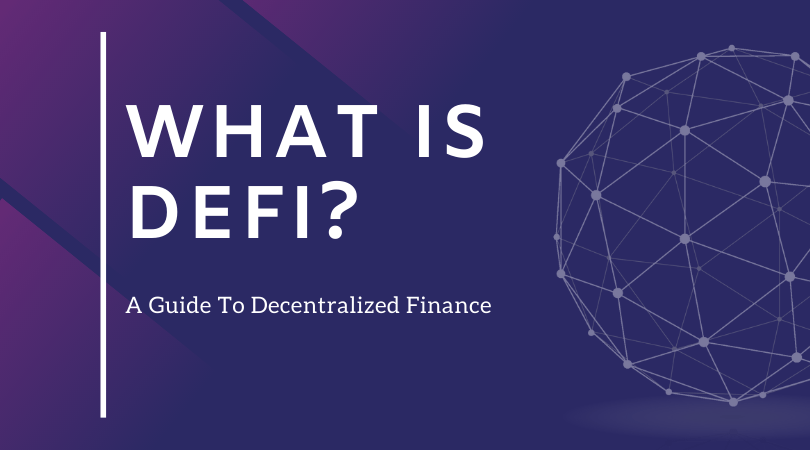- Published on
Sustainable Future With DeFi
5 min read
- Authors
- Name
- Sajid Javed
- @sajid.javed

Table of Contents
DeFi exploded onto the scene in 2020 as the value locked in decentralized platforms climbed into the billions. Yield farming, flash loans, and automated market makers (AMMs) were a few of the hottest topics over the last year. But what does the future of DeFi hold? And will the next round of innovations take advantage of DeFi’s accessibility, decentralization, and grassroots community-building to make the world a better place?
What Is Decentralized Finance (DeFi)?
Decentralized finance — often called DeFi — refers to the shift from traditional, centralized financial systems to peer-to-peer finance enabled by decentralized technologies built on the Ethereum blockchain.
Whereas our traditional financial system runs on a centralized infrastructure that is managed by central authorities, institutions, and intermediaries, decentralized finance is powered by code that is running on the decentralized infrastructure of the Ethereum blockchain. By deploying immutable smart contracts on Ethereum, DeFi developers can launch financial protocols and platforms that run exactly as programmed and that are available to anyone with an Internet connection.
The breakthrough of DeFi is that crypto-assets can now be put to use in ways not possible with fiat or “real world” assets. Decentralized exchanges, synthetic assets, and flash loans are completely novel applications that can only exist on blockchains. This paradigm shift in financial infrastructure presents a number of advantages with regard to risk, trust, and opportunity.
Benefits of Decentralized Finance

Decentralized finance leverages key principles of the Ethereum blockchain to increase financial security and transparency, unlock liquidity and growth opportunities, and support an integrated and standardized economic system.
- Programmability. Highly programmable smart contracts automate execution and enable the creation of new financial instruments and digital assets.
- Immutability. Tamper-proof data coordination across a blockchain’s decentralized architecture increases security and audibility.
- Interoperability. Ethereum’s composable software stack ensures that DeFi protocols and applications are built to integrate and complement one another. With DeFi, developers and product teams have the flexibility to build on top of existing protocols, customize interfaces, and integrate third-party applications. For this reason, people often call DeFi protocols “money legos.”
- Transparency. On the public Ethereum blockchain, every transaction is broadcast to and verified by other users on the network (note: Ethereum addresses are encrypted keys that are pseudo-anonymous). This level of transparency around transaction data not only allows for rich data analysis but also ensures that network activity is available to any user. Ethereum and the DeFi protocols running on it are also built with open source code that is available for anyone to view, audit, and build upon.
- Permissionless. Unlike traditional finance, DeFi is defined by its open, permissionless access: anyone with a crypto wallet and an Internet connection, regardless of their geography and often without any minimum amount of funds required, can access DeFi applications built on Ethereum.
- Self-Custody. By using Web3 wallets like MetaMask to interact with permissionless financial applications and protocols, DeFi market participants always keep custody of their assets and control of their personal data.
How DeFi Is Being Used Now
DeFI is making its way into a wide variety of simple and complex financial transactions. It’s powered by decentralized apps called “dapps,” or other programs called “protocols.” Dapps and protocols handle transactions in the two main cryptocurrencies, Bitcoin (BTC) and Ethereum (ETH).
While Bitcoin is the more popular cryptocurrency, Ethereum is much more adaptable to a wider variety of uses, meaning much of the dapp and protocol landscape uses Ethereum-based code.
Here are some use cases:
- Traditional financial transactions. Anything from payments, trading securities and insurance, to lending and borrowing are already happening with DeFi.
- Decentralized exchanges (DEXs). Right now, most cryptocurrency investors use centralized exchanges like Coinbase or Gemini. DEXs facilitate peer-to-peer financial transactions and let users retain control over their money.
- E-wallets. DeFi developers are creating digital wallets that can operate independently of the largest cryptocurrency exchanges and give investors access to everything from cryptocurrency to blockchain-based games.
- Stable coins. While cryptocurrencies are notoriously volatile, stable coins attempt to stabilize their values by tying them to non-crypto currencies, like the U.S. dollar.
- Non-fungible tokens (NFTs). NFTs create digital assets out of typically non-tradable assets, like videos of slam dunks or the first tweet on Twitter. NFTs commodify the previously uncommodifiable.
- Flash loans. These are cryptocurrency loans that borrow and repay funds in the same transaction. Think of flash loans as decentralized arbitrage.
How You Should Get Involved With DeFi
If you’d like to get involved with DeFi, here are a few ways to get started:
- Get a Crypto Wallet: Start by setting up an Ethereum wallet like Metamask, then funding it with Ethereum. Self-custody wallets are your ticket to the world of DeFi, but make sure to save your public and private key. Lose these, and you won’t be able to get back into your wallet.
- Look into Stablecoins: An exciting way to try out DeFi without exposing oneself to the price swings of an underlying asset is to try out TrueFi, which offers competitive returns on stablecoins (AKA dollar-backed tokens, which aren’t subject to price movements).
Remember, the cryptocurrency and DeFi worlds are fast-moving and there’s significant potential for loss.
What's the Future of DeFi
DeFi is attracting huge amounts of liquidity, both from retail and institutional investors alike. This influx of fresh capital will continue as long as the benefits outweigh the risks. Like with all nascent innovations, there are teething problems and the sector as a whole has to overcome those in order to level a prosperous breeding ground for even more radical and disruptive fintech innovations.
If the past is any indicator of future success, then it’ll be hard to stop this DeFi train approaching its final destination — financial freedom for people all around the world.